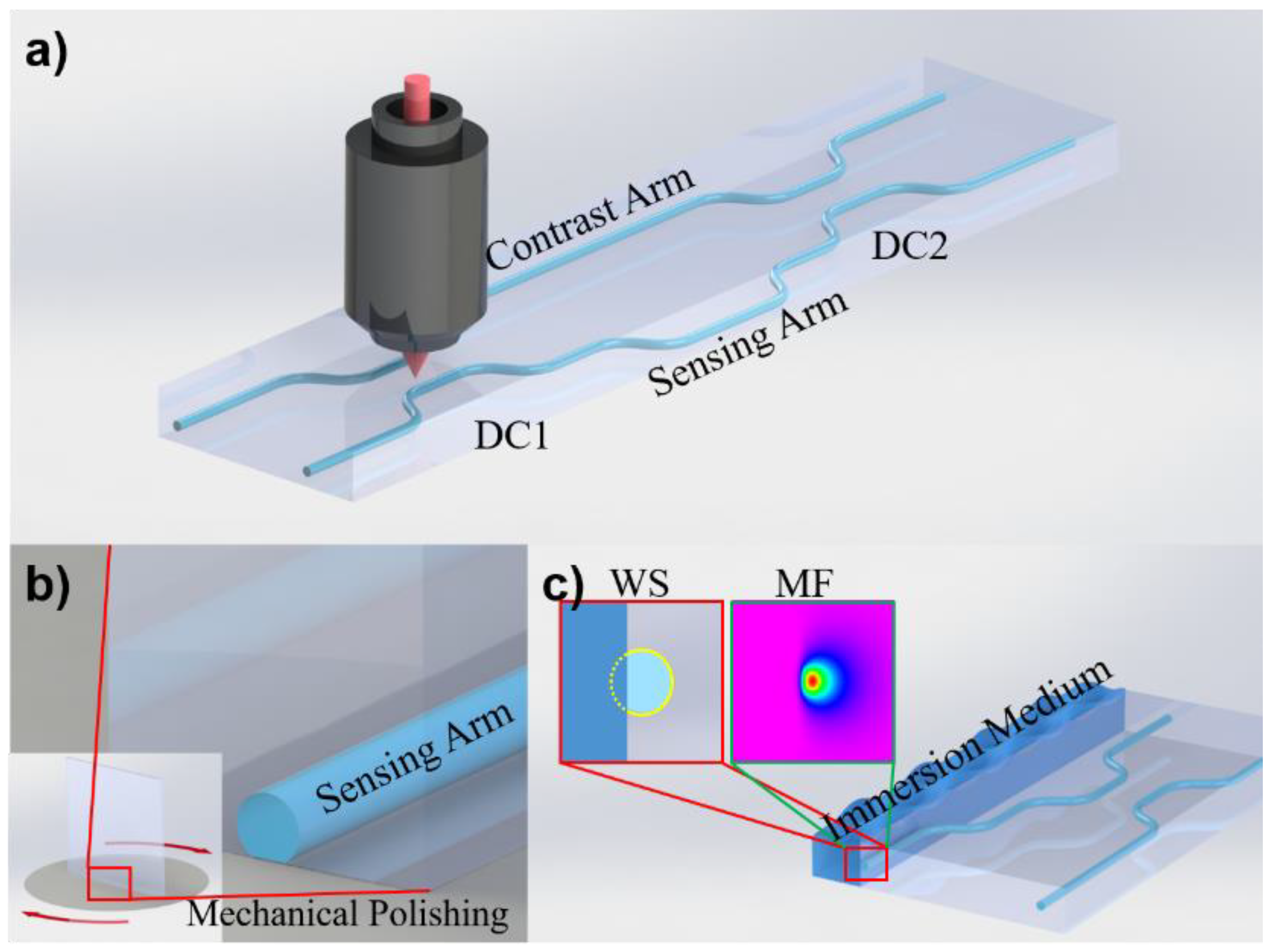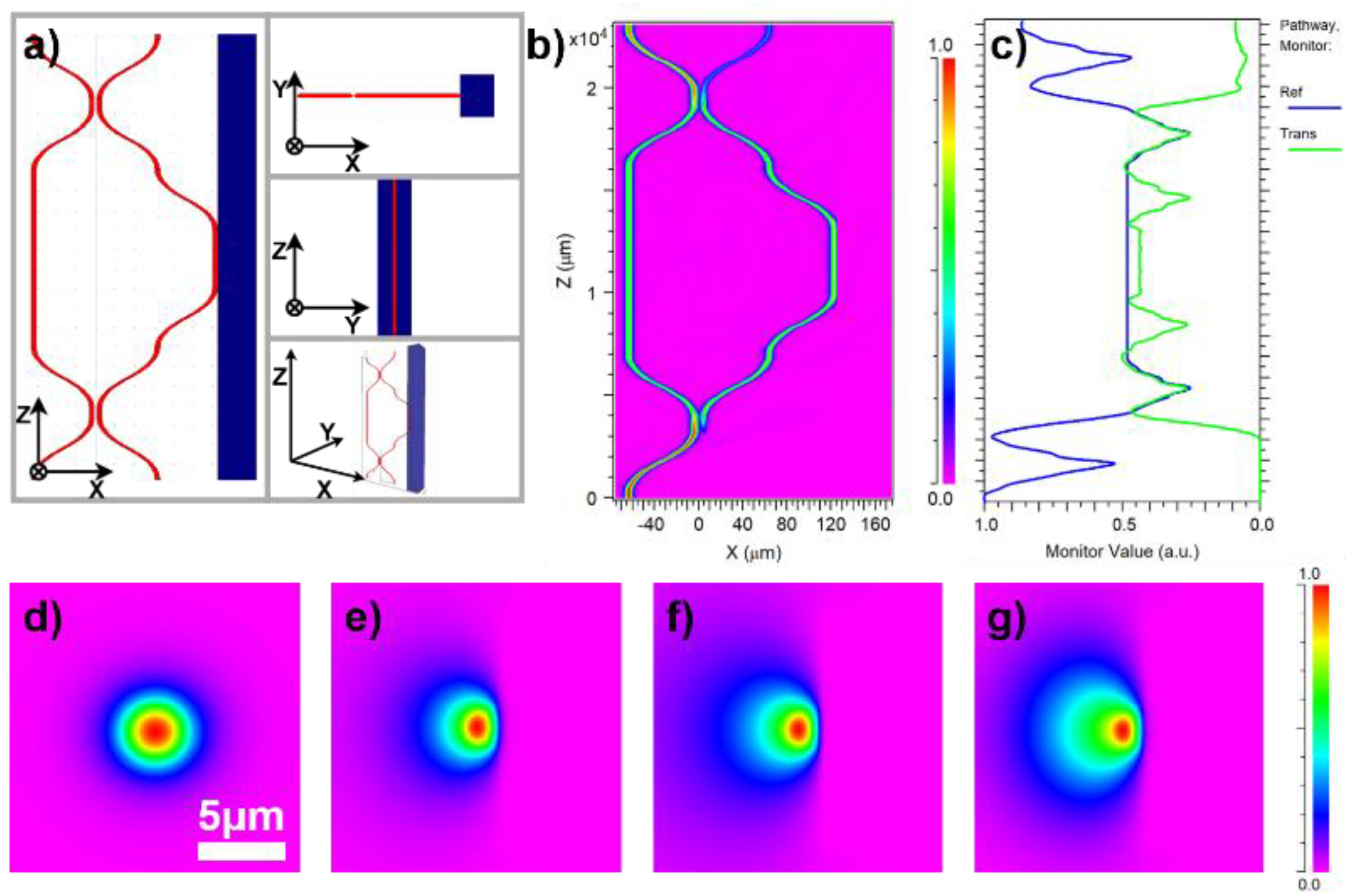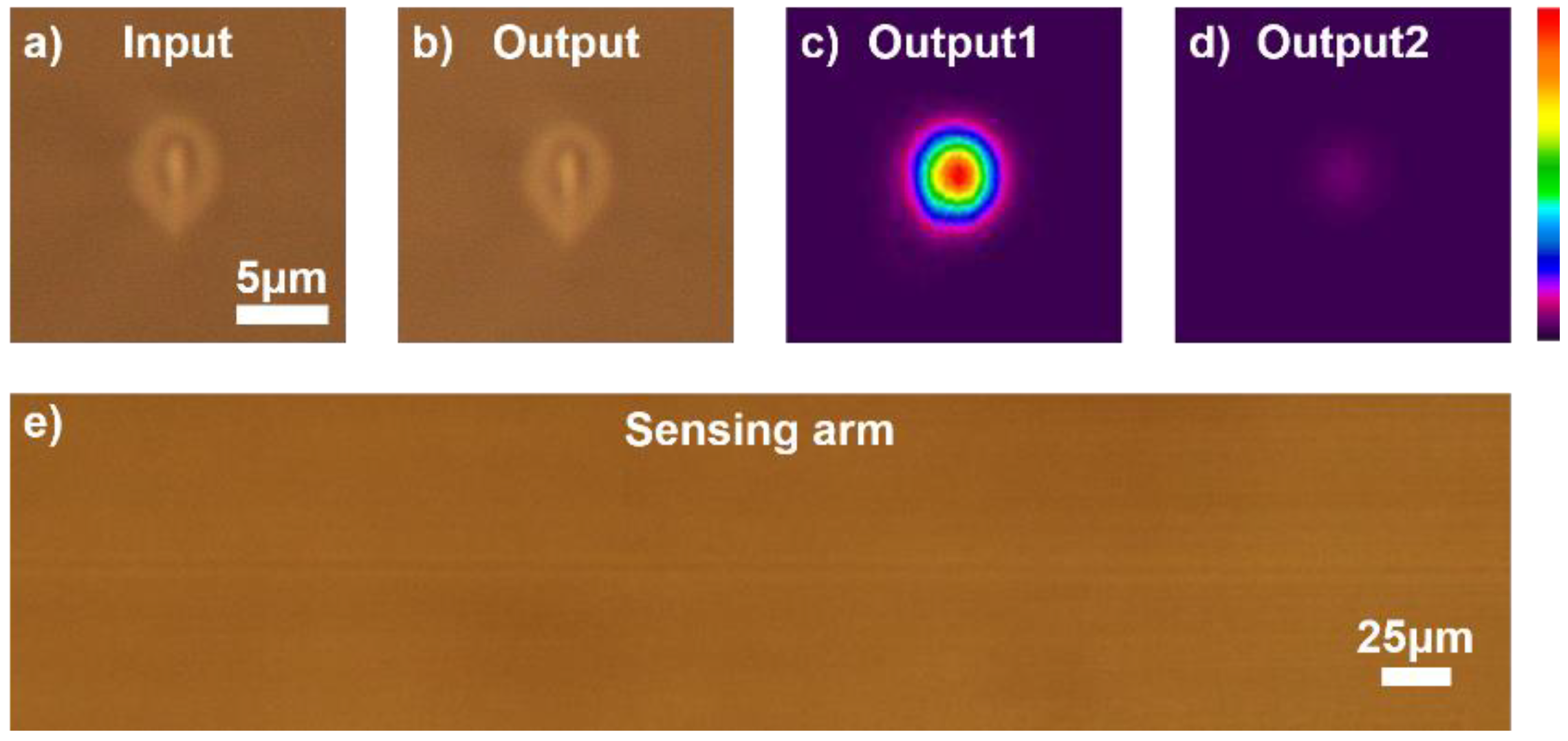Evanescent Field Controllable MZ Sensor via Femtosecond Laser Processing and Mechanic Polishing
Abstract
:1. Introduction
2. Principles and Simulation
3. Experiment and Results
4. Conclusions
Author Contributions
Funding
Conflicts of Interest
References
- Martin-Palma, R.J.; Mathias, K. Invited Biomimetic Photonic Structures for Optical Sensing. Opt. Laser Technol. 2019, 109, 270–277. [Google Scholar] [CrossRef]
- Barczak, K.; Pustelny, T.; Dorosz, D.; Dorosz, J. Optical Fibre Current Sensor for Electric Power Industry. Acta Phys. Pol. A 2010, 118, 1087–1089. [Google Scholar] [CrossRef]
- Deng, M.; Yong, Z.; Fengyang, Y.; Tao, Z. Interferometric Fiber-Optic Tilt Sensor Exploiting Taper and Lateral-Offset Fusing Splicing. IEEE Photonics Technol. Lett. 2016, 28, 2225–2228. [Google Scholar] [CrossRef]
- Baldwin, C. Optical Fiber Sensing in the Oil and Gas Industry: Overcoming Challenges. In Proceedings of the 23rd International Conference on Optical Fibre Sensors, Santander, Spain, 2–6 June 2014. [Google Scholar]
- Novo, C.; Bilro, L.; Ferreira, R.; Alberto, N.; Antunes, P.; Leitao, C.; Nogueira, R.; Pinto, J.L. Plastic Optical Fibre Sensor for Quality Control in Food Industry. In Proceedings of the Fifth European Workshop on Optical Fibre Sensors, Krakow, Poland, 19–22 May 2013. [Google Scholar]
- Baldini, F.; Mignani, A.G. Optical-Fiber Medical Sensors. MRS Bull. 2002, 27, 383–387. [Google Scholar] [CrossRef]
- Kohler, D.; Schindler, G.; Hahn, L.; Milvich, J.; Hofmann, A.; Länge, K.; Freude, W.; Koos, C. Biophotonic sensors with integrated Si3N4-organic hybrid (SiNOH) lasers for point-of-care diagnostics. Light Sci. Appl. 2021, 10, 64. [Google Scholar] [CrossRef] [PubMed]
- Zou, M.; Liao, C.; Liu, S.; Xiong, C.; Zhao, C.; Zhao, J.; Gan, Z.; Chen, Y.; Yang, K.; Liu, D.; et al. Fiber-tip polymer clamped-beam probe for high-sensitivity nanoforce measurements. Light Sci. Appl. 2021, 10, 171. [Google Scholar] [CrossRef] [PubMed]
- Scholler, J.; Groux, K.; Goureau, O.; Sahel, J.-A.; Fink, M.; Reichman, S.; Boccara, C.; Grieve, K. Dynamic full-field optical coherence tomography: 3D live-imaging of retinal organoids. Light Sci. Appl. 2020, 9, 140. [Google Scholar] [CrossRef] [PubMed]
- Kazanskiy, N.L.; Khonina, S.N.; Butt, M.A.; Kaźmierczak, A.; Piramidowicz, R. State-of-the-Art Optical Devices for Biomedical Sensing Applications—A Review. Electronics 2021, 10, 973. [Google Scholar] [CrossRef]
- Zhao, Y.; Hu, X.-G.; Hu, S.; Peng, Y. Applications of fiber-optic biochemical sensor in microfluidic chips: A review. Biosens. Bioelectron. 2020, 166, 112447. [Google Scholar] [CrossRef] [PubMed]
- Chen, S.; Zhuo, M.-P.; Wang, X.-D.; Wei, G.-Q.; Liao, L.-S. Optical waveguides based on one-dimensional organic crystals. PhotoniX 2021, 2, 2. [Google Scholar] [CrossRef]
- Muellner, P.; Bruck, R.; Baus, M.; Karl, M.; Wahlbrink, T.; Hainberger, R. Silicon photonic MZI sensor array employing on-chip wavelength multiplexing. Opt. Quantum Electron. 2012, 44, 557–562. [Google Scholar] [CrossRef]
- Khan, A.; Krupin, O.; Lisicka-Skrzek, E.; Berini, P. Mach-Zehnder refractometric sensor using long-range surface plasmon waveguides. Appl. Phys. Lett. 2013, 103, 111108. [Google Scholar] [CrossRef]
- Hu, Z.-Y.; Ren, H.; Xia, H.; Tian, Z.-N.; Qi, J.-L.; Wen, M.; Chen, Q.-D.; Sun, H.-B. Two-Photon Polymerization Nanomanufacturing Based on the Definition–Reinforcement–Solidification (DRS) Strategy. J. Light. Technol. 2021, 39, 2091–2098. [Google Scholar] [CrossRef]
- Hu, Z.-Y.; Tian, Z.-N.; Hua, J.-G.; Chen, Q.-D.; Sun, H.-B. Axially controllable multiple orbital angular momentum beam generator. Appl. Phys. Lett. 2020, 117, 021101. [Google Scholar] [CrossRef]
- Sugioka, K.; Cheng, Y. Ultrafast lasers—reliable tools for advanced materials processing. Light Sci. Appl. 2014, 3, e149. [Google Scholar] [CrossRef]
- Malinauskas, M.; Žukauskas, A.; Hasegawa, S.; Hayasaki, Y.; Mizeikis, V.; Buividas, R.; Juodkazis, S. Ultrafast laser processing of materials: From science to industry. Light Sci. Appl. 2016, 5, e16133. [Google Scholar] [CrossRef] [PubMed] [Green Version]
- Flamini, F.; Magrini, L.; Rab, A.S.; Spagnolo, N.; D’Ambrosio, V.; Mataloni, P.; Sciarrino, F.; Zandrini, T.; Crespi, A.; Ramponi, R.; et al. Thermally reconfigurable quantum photonic circuits at telecom wavelength by femtosecond laser micromachining. Light Sci. Appl. 2015, 4, e354. [Google Scholar] [CrossRef] [Green Version]
- Vlk, M.; Datta, A.; Alberti, S.; Yallew, H.D.; Jágerská, J. Extraordinary Evanescent Field Confinement Waveguide Sensor for Mid-Infrared Trace Gas Spectroscopy. Light Sci. Appl. 2021, 10, 26. [Google Scholar] [CrossRef]
- Ahmad, M.; Hench, L.L. Effect of taper geometries and launch angle on evanescent wave penetration depth in optical fibers. Biosens. Bioelectron. 2005, 20, 1312–1319. [Google Scholar] [CrossRef] [PubMed]
- Wang, X.B. Theorem for the Beam-Splitter Entangler. Phys. Rev. A 2002, 66, 024303. [Google Scholar]
- Liu, Y.; Sun, Y.; Yi, Y.-J.; Tian, L.; Cao, Y.; Chen, C.-M.; Sun, X.-Q.; Zhang, D.-M. All polymer asymmetric Mach–Zehnder interferometer waveguide sensor by imprinting bonding and laser polishing. Chin. Phys. B 2017, 26, 124215. [Google Scholar] [CrossRef]
- Seyringer, D.; Lenka, G.; Jozef, C.; Dana, F.; Uherek, F. Comparison of Silicon Nitride Based 8-Channel 100-Ghz Awgs Applying Different Waveguide Structures; University of Zilina in EDIS-Publishing Centre of UZ: Zilina, Slovakia, 2019. [Google Scholar]
- Snyman, L.W.; Okhai, T. Design and Simulation of Optical Micro-Structures in Silicon Integrated Circuitry with Si Avalanche Mode Light Emitters, Excel Optical Ray Tracing and Rsoft Optical Simulation. In Proceedings of the Fifth Conference on Sensors, Mems, and Electro-Optic Systems, Skukuza, South Africa, 8–10 October 2018. [Google Scholar]
- Sun, Y.-L.; Dong, W.-F.; Niu, L.-G.; Jiang, T.; Liu, D.-X.; Zhang, L.; Wang, Y.-S.; Chen, Q.-D.; Kim, D.-P.; Sun, H.-B. Protein-based soft micro-optics fabricated by femtosecond laser direct writing. Light Sci. Appl. 2014, 3, e129. [Google Scholar] [CrossRef]
- Ye, J.; Ma, X.; Zhang, Y.; Xu, J.; Zhang, H.; Yao, T.; Leng, J.; Zhou, P. From spectral broadening to recompression: Dynamics of incoherent optical waves propagating in the fiber. PhotoniX 2021, 2, 15. [Google Scholar] [CrossRef]
- Yu, F.; Wang, L.-C.; Chen, Y.; Chen, Q.-D.; Tian, Z.-N.; Ren, X.-F.; Sun, H.-B. Polarization Independent Quantum Devices With Ultra-Low Birefringence Glass Waveguides. J. Light. Technol. 2021, 39, 1451–1457. [Google Scholar] [CrossRef]
- Wang, Y.D.; Yu, Y.H.; Tian, Z.N.; Chen, Q.D. Influence of Laser Pulse Width on the Performance of Glass Waveguide. Acta Photonica Sin. 2021, 50, 0650108. [Google Scholar]
- Marcinkevičius, A.; Mizeikis, V.; Juodkazis, S.; Matsuo, S.; Misawa, H. Effect of refractive index-mismatch on laser microfabrication in silica glass. Appl. Phys. A 2003, 76, 257–260. [Google Scholar] [CrossRef]
- Jette-Charbonneau, S.; Lahoud, N.; Charbonneau, R.; Mattiussi, G.; Berini, P. End-Facet Polishing of Surface Plasmon Waveguides in Lithium Niobate. IEEE Trans. Adv. Packag. 2008, 31, 479–483. [Google Scholar] [CrossRef]
- Li, Z.-Z.; Li, X.-Y.; Yu, F.; Chen, Q.-D.; Tian, Z.-N.; Sun, H.-B. Circular cross section waveguides processed by multi-foci-shaped femtosecond pulses. Opt. Lett. 2021, 46, 520–523. [Google Scholar] [CrossRef] [PubMed]
- Eaton, S.M.; Zhang, Z.; Herman, P.R.; Yoshino, F.; Shah, L.; Bovatsek, J.; Arai, A.Y. Heat Accumulation Effects in Femtosecond Laser-Written Waveguides with Variable Repetition Rate. Opt. Express 2005, 13, 4708–4716. [Google Scholar] [CrossRef] [PubMed]
- Eaton, S.M.; Zhang, Z.; Ng, M.L.; Li, J.; Chen, W.-J.; Ho, S.; Herman, P.R. Optics express Herman. Transition from Thermal Diffusion to Heat Accumulation in High Repetition Rate Femtosecond Laser Writing of Buried Optical Waveguides. Opt. Express 2008, 16, 9443–9458. [Google Scholar] [CrossRef]




Publisher’s Note: MDPI stays neutral with regard to jurisdictional claims in published maps and institutional affiliations. |
© 2021 by the authors. Licensee MDPI, Basel, Switzerland. This article is an open access article distributed under the terms and conditions of the Creative Commons Attribution (CC BY) license (https://creativecommons.org/licenses/by/4.0/).
Share and Cite
Zhang, Z.-D.; Duan, Y.-Z.; Guo, Q.; Gao, S.; Gao, B.-R. Evanescent Field Controllable MZ Sensor via Femtosecond Laser Processing and Mechanic Polishing. Micromachines 2021, 12, 1421. https://doi.org/10.3390/mi12111421
Zhang Z-D, Duan Y-Z, Guo Q, Gao S, Gao B-R. Evanescent Field Controllable MZ Sensor via Femtosecond Laser Processing and Mechanic Polishing. Micromachines. 2021; 12(11):1421. https://doi.org/10.3390/mi12111421
Chicago/Turabian StyleZhang, Zong-Da, Yan-Zhao Duan, Qi Guo, Si Gao, and Bing-Rong Gao. 2021. "Evanescent Field Controllable MZ Sensor via Femtosecond Laser Processing and Mechanic Polishing" Micromachines 12, no. 11: 1421. https://doi.org/10.3390/mi12111421
APA StyleZhang, Z.-D., Duan, Y.-Z., Guo, Q., Gao, S., & Gao, B.-R. (2021). Evanescent Field Controllable MZ Sensor via Femtosecond Laser Processing and Mechanic Polishing. Micromachines, 12(11), 1421. https://doi.org/10.3390/mi12111421




